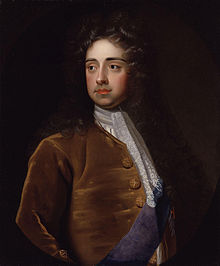
Back تشارلز تالبوت ARZ Charles Talbot, 1. vévoda ze Shrewsbury Czech Charles Talbot, 1. Duke of Shrewsbury German Charles Talbot (1er duc de Shrewsbury) French צ'ארלס טלבוט, הדוכס הראשון משרוסברי HE Charles Talbot, I duca di Shrewsbury Italian チャールズ・タルボット (初代シュルーズベリー公爵) Japanese Charles Talbot (1. książę Shrewsbury) Polish Толбот, Чарльз, 1-й герцог Шрусбери Russian Charles Talbot, 1:e hertig av Shrewsbury Swedish

This article's lead section may be too long. (July 2022) |
Charles Talbot, 1st Duke of Shrewsbury KG PC (15 July 1660 – 1 February 1718) was an English peer and Whig politician who was part of the Immortal Seven group which invited William of Orange to depose King James II of England during the Glorious Revolution. He was appointed to several minor roles before the revolution, but came to prominence as a member of William's government. Born to Roman Catholic parents, he remained in that faith until 1679 when—during the time of the Popish Plot and following the advice of the divine John Tillotson—he converted to the Church of England.[1] Shrewsbury took his seat in the House of Lords in 1680 and three years later was appointed Gentleman-Extraordinary of the Bedchamber, suggesting he was in favour at the court of Charles II.[1]
With the accession in 1685 of James II, Shrewsbury was appointed a captain in order to defeat the Monmouth rebellion, although he resigned his commission in 1687 after refusing to bow to pressure from James to convert back to the Catholic faith.[1] Making contact with William of Orange, Shrewsbury's home became a meeting place for the opposition to James II and Shrewsbury was one of seven English statesmen to sign the invitation to William to invade England in June 1688. In September he fled England for Holland and returned with William to England in November. Shrewsbury was influential in the making of the Revolution Settlement, arguing strongly in favour of recognising William and Mary as sovereigns.[1] Shrewsbury resigned from William's government in 1690 due to ill health and his opposition to the dissolution of Parliament and the dropping of the Bill that would have required an oath abjuring James as King. In opposition, Shrewsbury contacted the exiled Stuart court in France as a prelude to a Stuart restoration. In 1694, Shrewsbury returned to government and was prominent in persuading the House of Commons to vote for the funds needed for William's war against France. Ill health led to his resignation in 1698, but he returned to the government in 1699 until resigning again in 1700.[1]
From 1700 until 1705, Shrewsbury was in self-imposed exile abroad, during which he married Countess Adelhida Paleotti. In April 1710 Shrewsbury return to government and was an early supporter of the Tory efforts to negotiate peace with France to end the War of the Spanish Succession, concerned at the negative financial impact it was having on landowners. However, he was uncomfortable with peace negotiations that left out Britain's ally, the Dutch. In November 1712 he was appointed ambassador to France and then Lord Lieutenant of Ireland, returning to England in June 1714.[1]
In July Shrewsbury was appointed Lord Treasurer but in August Queen Anne died and George I succeeded her. The new Whig regime opposed Shrewsbury remaining in government and by 1715 he had lost all his governmental offices, although until his death he remained George's Groom of the Stool. Shrewsbury opposed the Whigs' attack on the previous Tory ministers and opposed their other policies in the Lords, making contact with the Stuart Pretender and sending him money. He died in 1718.[1]
© MMXXIII Rich X Search. We shall prevail. All rights reserved. Rich X Search
